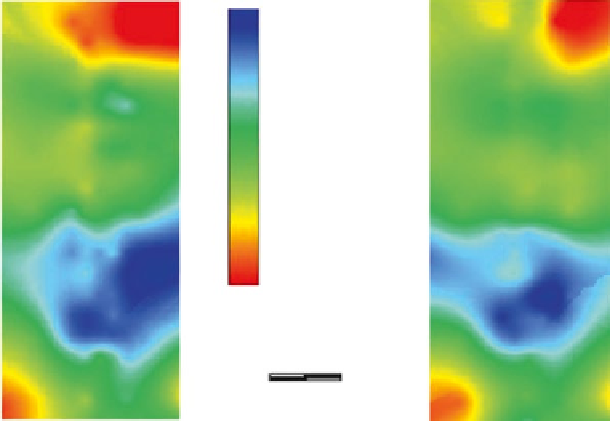Agriculture Reference
In-Depth Information
mg / kg dry soil
30
35
chem. analysis in lab.
on-the-go sensed
40
45
50
55
60
65
40 meters
Fig. 9.14
Site-specific maps of plant available phosphorus for a field with silt loam in Belgium as
obtained from chemical analyses in a laboratory (
left
) and from spectroscopic on-the-go sensing
(
right
). The data for the chemical analyses as well as for the spectroscopic sensing were recorded
at precisely the same georeferenced 126 locations. After that, the maps were created by kriging on
a 1 × 1 m grid. So in effect, the two methods of analysing or detecting the phosphorus are only
compared for specific spots in the field, they are not at all compared in their ability to resolve an
area adequately at reasonable costs for site-specific farming (From Mouazen et al.
2009
, altered)
If the soil phosphorus supply is mapped, the time lag situation would be somewhat
different. The time lags that occur during the mapping process as well as those that
result from the subsequent spreading operation together would have to be consid-
ered. In case the time lags, the travel directions and the operating speeds - from
mapping and from spreading - are the same, the offset distances cancel each other.
Yet there can be many different situations, and georeferenced path control is essen-
tial. For mapping, it seems reasonable to combine the flat surface sensing with a
cultivating process.
The spatial comparison of detecting plant available phosphorus in Fig.
9.14
by
spectroscopic sensing on the one hand and by conventional, chemical analysing in
a laboratory on the other hand is based on specific spots in a field. It demonstrates
that the spectral on-the-go method (Fig.
9.13
) can provide for a similar result in the
field as the chemical analysing can in the laboratory - for single spots. This princi-
pal precision in detecting the phosphorus is the prerequisite for using the high spa-
tial resolution that is needed for site-specific application. It is obvious that in practice
any analysing in laboratories never can provide this spatial resolution because of its
high costs.
In field trials with maize in Belgium for which the phosphate fertilisers were
either uniformly applied or distributed in a site-specific way according to the method
in Fig.
9.13
, the site-specific application resulted in a small saving of fertiliser of

